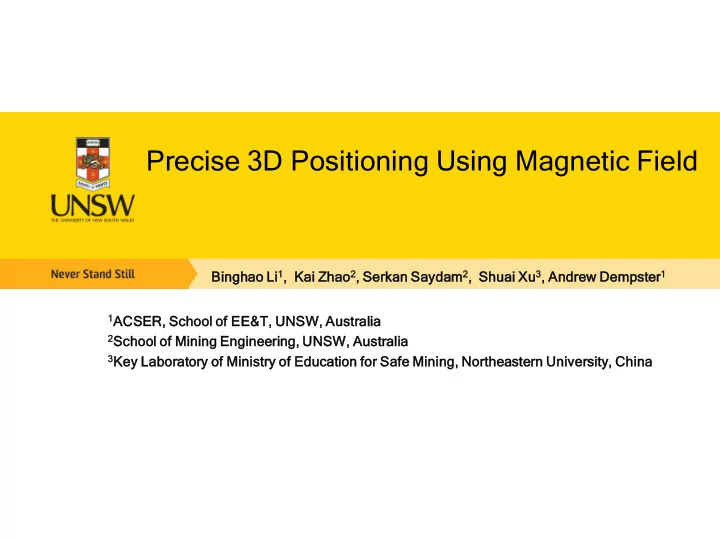

Precise 3D Positioning Using Magnetic Field Bingh inghao ao Li Li 1 , Kai ai Zhao hao 2 , S Ser erkan S n Say ayda dam 2 , Shuai X huai Xu 3 , A Andr ndrew D Dem emps pster 1 1 ACSER, S Schoo hool of l of EE&T, UNSW, A Aus ustral alia ia 2 Schoo ool of l of Mining E ining Engine ngineering, g, U UNSW, Aus ustrali lia 3 Key ey Labor Laborat atory of of Minis inistry of of Educ ducat ation on for or Saf afe e Mining, ining, Nor orthe heastern Univ niver ersit ity, China hina
O UTLIN INE • Introd oduc ucti tion on • Using G ng Geom eomagn agnet etic F Fiel eld d for for 3D 3D Pos ositioni ning ng • Addi dding ng Arti tificial al Magnet agnetic Fiel eld • Conc oncludi ding ng Rem emar arks
Usi sing ng a a Magn agnetic F Fiel eld d for or P Posi ositioning Based on pre-deployed infrastructure • (J. Blankenbach and A. Norrdine, 2010) Based on signals-of-opportunity • (J. Chung et al. 2011) Indooratlas
Previ evious us S Study ( dy (1) 1.4 1.2 x 1 y z 0.8 norm 0.6 0.4 0.2 0 -0.2 -0.4 0 0.5 1 1.5 2 2.5 x 10 6 1.4 1.2 x 1 y z 0.8 norm 0.6 0.4 0.2 0 -0.2 -0.4 0 0.5 1 1.5 2 2.5 x 10 6 24 hours stability
Previous Study (2) 0.8 L4 L3 0.6 X intensity L2 L1 0.4 LG 0.2 0 0 200 400 600 800 1000 1200 1400 0 -0.2 Y intensity -0.4 -0.6 -0.8 0 200 400 600 800 1000 1200 1400 1.5 Z intensity 1 0.5 0 200 400 600 800 1000 1200 1400 Location index Comparison of the measured magnetic intensities at overlapping corridors
Testing S ng Setup up • A 45*39*76cm wooden cabinet • A 30*40*60cm cuboid • 12 layers (Z direction) and each layer has 48 grids, in total 576 grids
The U he Uni niqu queness of of the M he Magn agnetic F c Fiel eld d • The average intensities of X, Y and Z directions of one layer (Z=2) • The change of the intensity is noticeable in all directions
The V he Var ariat ation of of Magn agnetic I c Int ntensities ( (1) 1)
Stat atic T Test est • 20 test points were randomly selected from 4 layers • NN applied • About 70%, the positioning errors are lease than 2 units (10cm)
Dyn ynamic T c Test est • The sensor was moved alone X=3 and Y=3 in layer Z=6. • Data were grouped every 10 samples as a test point • Error is quite large • Systematic offset
Addin ing A Artif ific icia ial M l Magnetic ic F Fie ield ld • 10 magnetic blocks • The magnetic force line against each other to achieve a significant change of the magnetic field
The V he Var ariat ation of of Magn agnetic I c Int ntensities ( (2) 2)
Stat atic T Test est ( (2) 2) • Test points (in total 240) extracted from data base • Applied NN and 4NN • A higher possibility position to the true location • Error <5cm NN:50% vs 86% 4NN:72% and 88% (85% <2.5cm).
Dynami mic c Test • Results are better • Systematic error in X=3 testing test disappear • Systematic error in Y=3 testing is smaller
F UT URE W ORK RK UTUR • The magnetic field positioning may find some specific applications • The long term stability of the magnetic field • Integration of IMU with magnetic field positioning • Increasing the fingerprint elements • Best way to deploy the magnetic blocks
T HA NKS HANK Questions?
Recommend
More recommend